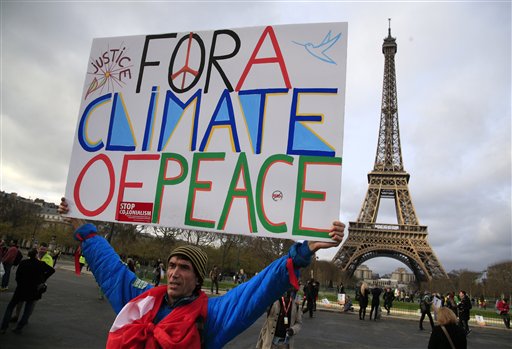In the following post, Miki Kashtan, author, co-founder of Bay Area NVC and lead collaboration consultant at The Center for Efficient Collaboration, offers her reflections on the process that brought 195 countries into consensus at the COP21. Then, Michael Nagler, President of the Metta Center for Nonviolence, responds with his additional thoughts regarding the principles of nonviolence therein.
Analysis by Miki Kashtan
195 of 195 countries. That caught my attention when my sister Arnina first told me about the Paris agreements.
So I started talking with people and reading articles. It took some days before I found anyone who talked about what to me was a revolutionary moment. Instead, the conversations and articles I found focused on whether what the countries of the world agreed to is enough or not. I, on the other hand, was looking to know and understand how all these countries managed to reach an agreement at all. I have no memory of ever before hearing of anything that all countries in the world could agree to about a topic of dramatic significance such as climate change. I am still piecing together this story, and have found, so far, only two useful articles. One appeared on Quartz, and the other on Rappler.
What I read only strengthened my initial heart-based hit that something extraordinary was going on, regardless of the specific results. Perhaps I am sensitized to such a focus because of the work that I do. Just recently I was involved in a much less dramatic though quite contentious issue, when I supported legislators and others in Minnesota in a project of collaborative lawmaking in the area of child custody. I both know how extremely difficult it is to bring people together, and also how transformative it is when successful.
Before continuing, I want to make it clear that in this piece, I am not addressing the details of the agreement itself. I am not an expert, and several people have already written extensive commentaries. The one I appreciated most so far is by John Sterman, and I invite interested readers who don’t yet have their own data or opinions about it to read it.
I am only focusing on what I see as an unprecedented event of enormous potential to address high-stakes conflicts anywhere. Here’s what I see as entirely new—assuming that this is, indeed, the first time for what I say below.
- The Indaba Process: this is the first time that all countries of the world, meaning all the countries of the Global North and the Global South, used an indigenous process that came from an African country. Indigenous wisdom, ancient practices, won the day; not anything coming out of Harvard or MIT. Now everyone knows that the Global South has gifts to contribute to the entire world.
- 100% consensus: this is the first time that all countries of the world agreed. This means rich and poor nations agreed. This means that countries that are in enemy status with each other agreed, even countries that are at war with each other. This agreement transcended all divisions and brought truly everyone together. No one can ever say again that it’s not possible.
- They stretched hard: sleep was not the main item on the agenda during the talks. People worked hard, almost around the clock, to reach agreement. Now the evidence is in that even in very, very hard circumstances, stretching remains possible. I am quite saddened to see so many in the environmental movement focus so much on how far there is still to go without acknowledging how far many countries have come. I want more of us to recognize that the negotiators are human beings like the rest of us, and that stretching is just as hard for them as it would be for anyone. There is no reason to give up on a process just because it’s hard. With good enough process and deep commitment, people and countries will stretch towards something that works for others, too.
- Hope: I don’t know the statistics. I know that many consider the outcome to be insufficient. Still, I see and hear much more hope than before. Hope is powerful.
What would happen if we brought Indaba to the Middle East? What if the same principles were applied with Israelis and Palestinians in the room? What if we brought CEOs of large energy companies into the same room with key climate change leaders and engaged them – with the Indaba process; with Convergent Facilitation, the process I developed for supporting groups in reaching collaborative solutions; with any and all other processes that we know work?
The principles are simple: What is truly important for everyone? What is a solution that can truly attend to all of that? How can we make things truly work for everyone?
The obstacles are surmountable. COP21 and a host of other far less visible examples demonstrate.
This, to me, is nonviolence in action. Nonviolent resistance is only an escalated version of dialogue. When effective process is used, there is no need to challenge the outcome. That’s when dialogue is indeed, as the Dalai Lama says, “the only sensible and intelligent way to resolving differences and clashes of interests, whether between individuals or nations.”
♠
(AP Photo/Thibault Camus)
Response to Miki Kashtan’s piece by Michael Nagler:
I would like to add two cents, in the form of two thoughts, to these excellent observations. Well, really three thoughts, but let’s fit them onto Miki’s point about Hope:
- As Miki points out, the tensions among enemy and other states were somewhat subsumed under the common task of averting the threat to everyone. This is what we have been hoping would come from environmental issues for decades. It is a perfect example of what Sharif and Sharif studied in their famous book, In Common Predicament: that there is nothing more effective at overcoming conflict than to have a problem you have to solve together: more effective than dining, celebrating, or just hanging out together, though all of these can be effective. Not only that, but one senses that the tensions between the protestors in the streets and the delegates in the board rooms were far less severe than they were, for example, at the WTO protests in Seattle or Miami. One example: a large coalition of the protesting organizations agreed to abide by the ban on protests called in response to the recent attacks on Paris by a cell of ISIS (even though they suspected the ban had been imposed in bad faith, actually to stop their protests). They said, however, that they would protest symbolically, e.g. by putting shoes in the boulevard representing prominent people and many others. This is a perfect example of what Gandhi called the “Principle of Non-Embarrassment,” which served him so well toward the climax of both his major campaigns, in South Africa and India.
Carrying this further:
- While it is undoubtedly true that COP21 did not in itself go far enough, that is, far enough to rescue the planet now, we should have a look at how far the nations have come. That’s good conflict policy: to acknowledge any steps toward accommodation that the opposition may take, however feeble. This is a lesson the left has yet to learn, so there’s a ray of hope in the fact that some commentators (well, a few) have actually noted this.











“awakening the right kind of power in people” by providing the rocket fuel of social change, hope, is really what it’s all about, and that’s why I keep telling people about the Roadmap and that word, “unstoppable.” People in despair need to see the bridge before they dare to set foot upon it.
“People in despair need to see the bridge before they dare to set foot upon it.” That’s a really great way to put it. Thanks for spreading the word about Roadmap! It’s a remarkable tool, especially the core, Person Power.